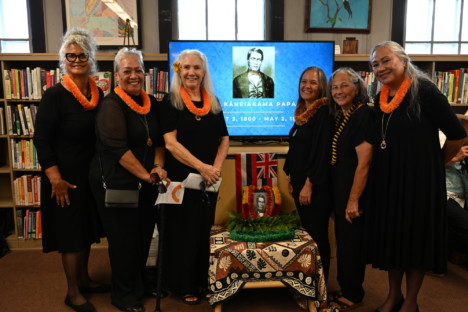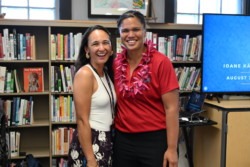Through the Words of John Papa ʻĪʻī
By Léo Azambuja
Some of the most invaluable insights on how Hawaiian kings and commoners lived in the 19th century came from the written accounts of a man who served four generations of the Kamehameha Dynasty and wielded a significant power and influence in the Kingdom.
“If anyone needed something to be done, they always seemed to call John Papa ʻĪʻī. He was the guy to get it done,” Awaiulu head researcher Kalei Roberts said at the E Hoʻomanaʻo series event at Molokai Public Library Aug. 26.
Close to 20 people came to the library to learn more about the life and legacy of Ioane Kāneiakama Papa ʻĪʻī — widely known as John Papa ʻĪʻī — including members of the Alu Like Kupuna Program and members of the Kaʻahumanu Society, Molokai Chapter 8.
Papa ʻĪʻī was born in Waipiʻo, Oahu Aug. 3, 1800. When he was only 10 years old, he was taken to Honolulu to serve as an attendant to Kamehameha I. Throughout his life, Papa ʻĪʻī would also serve Kamehameha II, Kamehameha III and Kamehameha IV in different capacities.
After the first missionaires arrived in Hawaii in 1820, Papa ʻĪʻī became one of the first Hawaiians to learn how to read and write under the mentorship of the Rev. Hiram Bingham.
In 1940, Papa ʻĪʻī became the kahu at the Chief’s Children’s School. The next year, he was named general superintendent of Oahu schools. In 1942, the king appointed him to the new Treasury Board, which was tasked with creating a regular and systematic account keeping.
In 1845, Papa ʻĪʻī was appointed as one of five members of the Board of Land Commissioners. Seven years later, he represented the House of Nobles in the 1852 Constitution drafting.
In the House of Nobles, Papa ʻĪʻī served from 1841 to 1854, and again from 1858 to 1868. In 1855, he served as a member of the House of Representatives, the other legislative body.
Papa ʻĪʻī also served in many commissions within the government, and also as a judge in the Superior Court and on the Supreme Court.
Roberts said Papa ʻĪʻī had a “very caring side” who made sure a young 10-year-old David Kalākaua — the boy who would become Hawaii’s last king — could visit his grandfather in jail after being sentenced to capital punishment.
Chief Kamanawa II was convicted of fatally poisoning his wife in 1840. He wanted to marry another woman, and Hawaii law at that time didn’t allow for divorce.
“This is the first time a chief of Hawaii is going to be publicly executed under Kingdom law,” Roberts said, adding “everyone was torn” because King Kauikeaouli, or Kamehameha III, had to issue the verdict and Papa ʻĪʻī had to ensure it gets carried out. Before the execution, Papa ʻĪʻī took Kalākaua and his brother to see their grandfather for the last time.
Papa ʻĪʻī died May 2, 1870, a few months short of celebrating 70 years old.
As a regular contributor to Hawaiian-language newspapers, his articles bring rare first-hand accounts of many facets of old Hawaii, and are a key resource for historians today. They were translated to English by Mary Kawena Pukui and first published in English in the book “Fragments of Hawaiian History” in 1959.
Awaiaulu, one of E Hoʻomanaʻo’s sponsors, is a nonprofit organization “dedicated to developing resources and resource people that can bridge Hawaiian knowledge from the past to the present and the future.” Roberts said many Hawaiian-language documents are being translated and becoming accessible to those who don’t speak Hawaiian or just want to learn more about what is available.
The E Hoʻomanaʻo program started in late 2023, highlighting a Hawaii chief or leading figure every last Tuesday of the month, according to Molokai Public Library branch manager Mia Langer Ritte.
She said the program was envisioned by Mercy Ritte, who picks the figure to be highlighted each month.
Since its inception, Langer Ritte said, the program has transformed and revitalized Molokai Public Library.
“A lot of people never felt comfortable here or didn’t feel like they belonged. But to have an event like this, has really brought people in who haven’t been to the library in 20 years,” she said.
Despite the small attendance last week — likely due to a summer break — this is the most popular program at the library, and is usually held outside on the lawn under a large tent to accommodate a crowd that sometimes reaches 80 people, according to Langer Ritte.
“I also think it’s just important to celebrate and recognize and remember the past and all of the people who have had an impact on the way we live today,” she said.
At the beginning of the event, about 20 kids from Molokai High School Hawaiian Immersion Program, ages 14 to 18, sang to the audience.
Sponsors and partners of the E Hoʻomanao program include Kaiāulu, Kaneokana, Molokai Middle School’s Hawaiian Language Immersion Program, Awaiulu, ʻĀina Momona, Alu Like and Rooted.
Visit https://www.librarieshawaii.org/branch/molokai-public-library/ to stay updated on the library’s events.













Don't have a Molokai Dispatch ID?
Sign up is easy. Sign up now
You must login to post a comment.
Lost Password